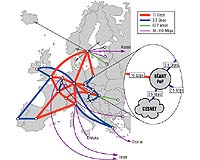 |
Washington (UPI) Sep 27, 2010 Space security surveillance received a new boost with advances in satellite technology announced by Boeing, Ball Aerospace and Orbital. New emphasis on space security is part of an overall U.S. government strategy that aims to ensure the space around Earth remains clear of dangerous debris and also free of security threats, whether emanating from terrestrial sources or from outer space. The Boeing Co. said it got initial on-orbit signals from the first Space Based Space Surveillance satellite after it launched at 9:41 p.m. Saturday from Vandenberg Air Force Base, Calif. The signals indicate the satellite is functioning normally and is ready to begin orbital maneuvers and operational testing, Boeing said. The SBSS Block 10 satellite, built for the U.S. Air Force by a Boeing-led team, was launched by an Orbital Sciences Minotaur IV rocket. The first signals from it were received a short time later. The Boeing SBSS Satellite Operations Center at Schriever Air Force Base, Colo., reported the satellite is "healthy." When it goes into operation with the Air Force, the SBSS satellite will be the service's only space-based sensor capable of detecting and monitoring debris, satellites and other space objects without the disruptions from weather, atmosphere or time of day that limit ground-based observations. The satellite and its ground system are expected to "dramatically improve the accuracy and timeliness of tracking and monitoring capabilities, and provide the flexibility to quickly respond to new and changing mission requirements," Boeing said. "The United States depends on space assets for security, communications, weather forecasting and many other essential services," said Craig Cooning, vice president and general manager, Boeing Space & Intelligence Systems. "America's adversaries recognize this increasing dependence, which makes the need for enhanced space situational awareness more and more vital. Today, the Air Force and Boeing SBSS team are delivering this advanced capability to the nation." Shortly after launch, the SBSS satellite began an automated sequence that deployed solar arrays, pointed them at the sun and initialized satellite operations. For the next two weeks, operators will perform health checks on the satellite bus, followed by payload checkout. Tests include sending simulated space situational awareness tasks to the SBSS Satellite Operations Center, which will send commands to the satellite and collect data from those tasks for the Air Force Joint Space Operations Center. The SBSS system is expected to be ready to perform its mission and be turned over to the Air Force in 60 days. David L. Taylor, president and chief executive officer of Ball Aerospace, a team member, called the launch "an important milestone to ensure" U.S. space assets are protected. Boeing was responsible for overall program management, systems engineering and integration, design and development and system operations and maintenance. Ball Aerospace developed, designed, manufactured, integrated and tested the satellite, using the Boeing-built on-board mission data processor. Orbital Sciences Corporation said the launch extends Orbital's record of launches with the Minotaur family of rockets to a perfect 18 successes out of a total of 18 missions. The Minotaur IV launch vehicle is based on decommissioned Peacekeeper rocket motors that Orbital upgraded and integrated with modern avionics and other subsystems to produce a cost-effective launcher based on flight-proven hardware. The launch of the SBSS satellite marked the first orbital mission for the Minotaur IV, which currently has a manifest of eight missions over the next several years. Ron Grabe, Orbital's executive vice president and general manager of its Launch Systems Group said "we are confident the Minotaur IV can provide the flexibility and reliability the air force demands." Orbital has eight subsequent Minotaur IV launches scheduled, the next of which will launch the STP-26 mission, a small developmental satellite for the Air Force, from the Alaska Spaceport launch complex in Kodiak, Alaska. Analysts said the successful launch of the SBSS satellite moved to a new level issues of space security amid a global proliferation of space satellite technology, now increasingly available to both friends and adversaries of the United States.
Share This Article With Planet Earth
Related Links Read the latest in Military Space Communications Technology at SpaceWar.com
 Modern infrastructures said 'vulnerable'
Modern infrastructures said 'vulnerable'London (UPI) Sep 18, 2010 Britain's electrical system, financial networks and transport infrastructure could be paralyzed by a solar flare or a nuclear attack, a U.K. official says. U.K. Defense Secretary Liam Fox is expected to deliver that warning next week at a summit of scientists and security advisers who believe the infrastructure that underpins modern life in Western economies is potentially vulnerable to ... read more |
|
| The content herein, unless otherwise known to be public domain, are Copyright 1995-2010 - SpaceDaily. AFP and UPI Wire Stories are copyright Agence France-Presse and United Press International. ESA Portal Reports are copyright European Space Agency. All NASA sourced material is public domain. Additional copyrights may apply in whole or part to other bona fide parties. Advertising does not imply endorsement,agreement or approval of any opinions, statements or information provided by SpaceDaily on any Web page published or hosted by SpaceDaily. Privacy Statement |